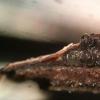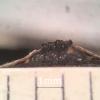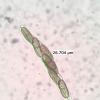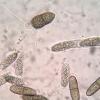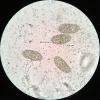
09-11-2025 13:20
Hello.A tiny ascomycete, appearing as erupting gra

08-11-2025 00:29
 Francois Guay
Francois Guay
I found this species in Quebec, Canada, on herbace

04-11-2025 09:07
Hello.A suspected Hymenoscyphus sprouting on a thi

04-11-2025 12:43
 Edvin Johannesen
Edvin Johannesen
Hi! One more found on old Populus tremula log in O

03-11-2025 21:34
 Edvin Johannesen
Edvin Johannesen
These tiny (0.4-0.5 mm diam.), whitish, short-stip
Immersed bitunicate pyrenomycete with spore appendages
Ethan Crenson,
17-01-2023 06:58
Hello all,
I found this immersed bitunicate pyrenomycete under the bark of what I think is Prunus. The tiny black necks in clusters of 8-10 appear to be growing through the lenticels of the bark. Perithecia are globose and about .5 mm wide.
Asci are bitunicate, measuring 200-215µm x 37-32µm.
Spores brown, 1-septate, ellipsoid, with a cushion-like spore appendage at each end. There are many spores that are broadly ellipsoid, but the majority of them are narrower. The narrower spores measure 44.7-48.4 x 14.2-17.2µm. The broadly ellipsoid spores are 36-38 x 18-19µm. The spore appendages seemed to dissolve in both Lugol's and India ink.
Can anyone suggest a genus? Does anyone know this pyreno?
Ethan
Bernard Declercq,
17-01-2023 11:42

Re : Immersed bitunicate pyrenomycete with spore appendages
Hi Ethan,
With its asci having such form and apical ring and swimming freely in the perithecial centre I would first of all look for in the Diaporthales (unitunicate asci).
Compare with Phaeodiaporthe appendiculata.
I agree, it is not always easy to make a distinction between thick-walled and bitunicate asci.
Bernard
With its asci having such form and apical ring and swimming freely in the perithecial centre I would first of all look for in the Diaporthales (unitunicate asci).
Compare with Phaeodiaporthe appendiculata.
I agree, it is not always easy to make a distinction between thick-walled and bitunicate asci.
Bernard
Ethan Crenson,
17-01-2023 15:14
Re : Immersed bitunicate pyrenomycete with spore appendages
Bernard,
First, thank you for the suggestion of Phaeodiaporthe appendiculata. It seems to fit quite well. Also, since this is not the first time that I've mistaken a thick walled unitunicate ascus for a bitunicate, can you suggest any guidance on making a better analysis? Well...yes, I suppose in my sixth picture, the apical ring is a hint. (Oops). But in the absence of that is there anything to look for?
Regards,
Ethan


